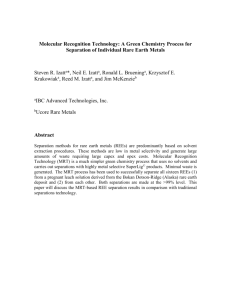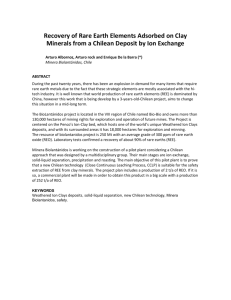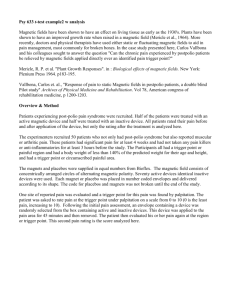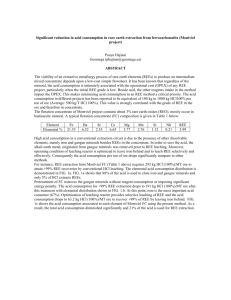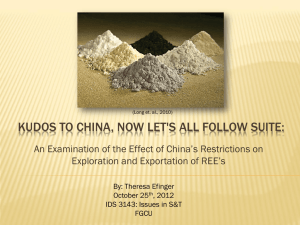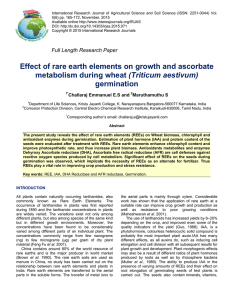Student pre-class reading for REE
advertisement
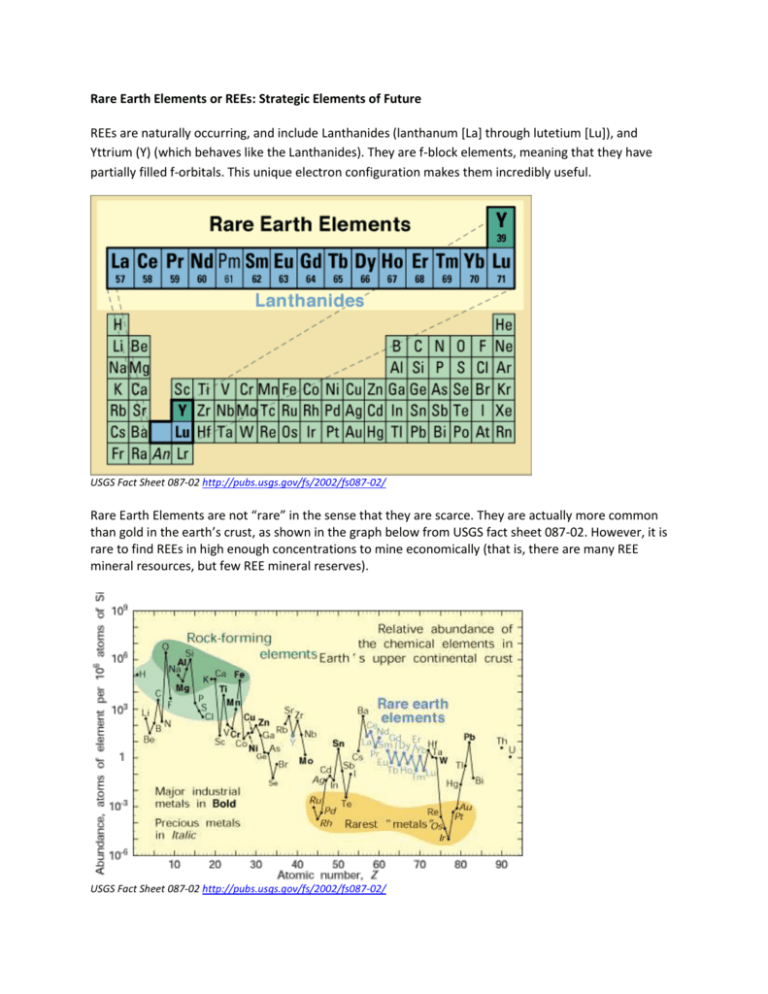
Rare Earth Elements or REEs: Strategic Elements of Future REEs are naturally occurring, and include Lanthanides (lanthanum [La] through lutetium [Lu]), and Yttrium (Y) (which behaves like the Lanthanides). They are f-block elements, meaning that they have partially filled f-orbitals. This unique electron configuration makes them incredibly useful. USGS Fact Sheet 087-02 http://pubs.usgs.gov/fs/2002/fs087-02/ Rare Earth Elements are not “rare” in the sense that they are scarce. They are actually more common than gold in the earth’s crust, as shown in the graph below from USGS fact sheet 087-02. However, it is rare to find REEs in high enough concentrations to mine economically (that is, there are many REE mineral resources, but few REE mineral reserves). USGS Fact Sheet 087-02 http://pubs.usgs.gov/fs/2002/fs087-02/ Uses for REEs: REEs such as cerium and/or lanthanum are used as catalysts in automotive converters and in petroleum refineries. By definition, a catalyst is a substance that helps to speed up a chemical reaction without being consumed in the reaction. Catalysts containing cerium and/or lanthanum (two of the REEs) can store and release oxygen and therefore can efficiently reduce carbon monoxide and nitrogen oxide (NOx) pollution from cars. Lanthanum and cerium are used in petroleum refineries as catalysts for breaking down heavier hydrocarbon molecules into lighter gasoline molecules (known as fluid cracking). This process increases gasoline yields and can also reduce sulfur dioxide pollution. REEs are also used in as polishing powders and additives for glass, and for making metal alloys, fluorescent light bulbs, TV and computer screens, NiMH (or Nickel-metal hydride) rechargeable batteries used in some hybrid cars, and so on. They are also extensively used in military equipment (lasers, batteries, radar and sonar technology, and motors). A major use of REE is in creating magnets. Because of the unique electronic configuration of REEs, REE alloys can be made into powerful permanent magnets, magnets that are much stronger than other types of magnets. REE-containing magnets can be a lot smaller and more lightweight than other magnets, which make them essential for things like computers and various car parts (e.g., both your cell phone and the motor that moves your car window up and down need to be very small, which is why they contain REE magnets). Smaller, stronger magnets are especially important for reducing the weight of motors in cars and hence increasing the car’s fuel efficiency. An electric motor with neodymium magnets is half the weight of a traditional motor. The electric motors that control your seats, mirrors, sunroofs, doors, windshield wipers, washer jets, ABS braking, as well as starter motors and alternators, all use neodymium (Nd) magnets. Permanent magnets are used in wind turbines for generating electricity. Permanent magnets containing REEs can significantly reduce the size and weight of the generator of larger (>2.5 Mega Watt), more powerful wind turbines. Stronger permanent magnets are also essential in wind turbines with electric generators that run at slower speeds than traditional wind turbines. These turbines can generate electricity at wind speeds lower than with traditional high-speed turbines, and are therefore more efficient and less prone to mechanical breakdown. Fluorescent light bulbs depend on phosphors made from the REEs terbium, europium, and yttrium. Phosphors are gases that convert energy into light, the color of which depends on the element present. For example, the red color produced on your TV comes from europium present in the phosphor. If the demand for fluorescent lights increases in the near future (because they are more energy efficient than incandescent light bulbs), then the demand for REEs will increase as well. Future technological uses of REEs include fuel cells and magnetic refrigeration. Fuel cells generate electricity from the energy released when hydrogen and oxygen are combined to form water. REEs are used as catalysts and other essential components in some varieties of fuel cells (e.g., solid oxide fuel cells). Conventional refrigerators use a pump to compress a gas (mostly hydrochlorofluorocarbons, or HCFCs), which then become cooler when it expands. Magnetic refrigeration is more environmentally friendly, partly due to the fact that it does not need to use refrigerants like HCFCs, which are greenhouse gases. (Chlorofluorocarbons, CFCs, were used as refrigerants before the 1990s, but were banned because they damage the ozone layer.) Also, the magnetic refrigeration process is more energy efficient than conventional refrigeration. Instead of using energy to compress gas, energy is used to create a magnetic field. Some rare earth elements, like gadolinium, become hot when they are placed in a magnetic field, and cold when the magnetic field is removed, with the amount of cooling depending on the strength of the magnetic field. In magnetic refrigeration, a piece of gadolinium alloy is placed in a strong magnetic field, and kept at room temperature by water or other coolants. It is then removed from the magnetic field, at which point the alloy becomes colder than room temperature. This cold alloy is used for cooling a second stream of water, which is then used for refrigeration. Since the use of technologies like fluorescent light bulbs, wind turbines, hybrid cars, automotive catalyst converters, fuel cell, and magnetic refrigeration are important for reducing greenhouse gas emissions, REEs are essential for the “green economy.” The Department of Energy (DOE) assesses the criticality of REEs by plotting the importance of specific rare earth elements against the possibility that their continued supply might be disrupted. The graphs below show the short-term and medium-term criticality of rare earth elements. Dysprosium, terbium, europium, neodymium, and yttrium, used in magnets for wind turbines and electric vehicles or as phosphors in energy-efficient lighting, are at risk of being in short supply to meet the demand between now and 2015 (short term) and are considered “Critical Materials.” They are expected to remain critical in the medium-term (between 2015 and 2025) as well. Short Term (Present–2015) Criticality Matrix. Medium Term (2015–2025) Criticality Matrix Figures and captions from US Department of Energy Critical Materials Strategy, 2011: http://energy.gov/sites/prod/files/DOE_CMS2011_FINAL_Full.pdf The importance of specific rare earth elements and their “critical” status changes with time and market dynamics. For example, lanthanum is used in petroleum refineries and is considered “near critical” in the short term. But the supply of lanthanum is relatively more certain than other REEs, and to some extent the refineries can control the amount of lanthanum they use. Therefore lanthanum is expected to be taken off the “Critical Materials” list during 2015–2025. Challenges of REE mining and processing Deposits of REE are found in some igneous and some sedimentary rocks. The igneous deposits (REE is found in alkaline igneous rocks and carbonatite) are very rare. Rarely, sedimentary placer deposits (piles of clastic sediment—rock and mineral fragments created by mechanical weathering—deposited in places like sand bars or beaches) can contain REE-bearing minerals like monazite and xenotime. More commonly, sedimentary processes (chemical weathering in tropical climates) can concentrate REE in soils. Deposits like these are found in China and Kazakhstan. (Soils affected by chemical weathering in this way are called laterites.) Processing REE ore is the biggest hurdle in the path of REE production. The fifteen rare earth elements naturally occur together in ore; they need to be separated but have very similar chemical properties. Separating them is therefore technologically challenging, cost and energy intensive, and time consuming. Different REE ores, such as monazite and bastnäsite, require different processing methods than the others. The lack of a single standardized processing method adds to the cost of processing and remains a technical challenge. In addition, common REE ores like monazite contain radioactive elements like thorium that must be properly disposed of. Safely extracting and removing radioactive byproducts, and safely disposing of thorium-rich mine waste is a huge challenge for REE mining in the United States. As of right now, the most commercially viable REE processing plants are located in China. Until other countries are able to economically separate the different REEs from the ore, China will remain the sole supplier of REEs in the global market. Currently, China controls more than 90% of global REE production. Map and caption from: US DOE Critical Materials Strategy, 2011 http://energy.gov/sites/prod/files/DOE_CMS2011_FINAL_Full.pdf All images provided in this document are public domain and can be freely used with citation for noncommercial purposes.
